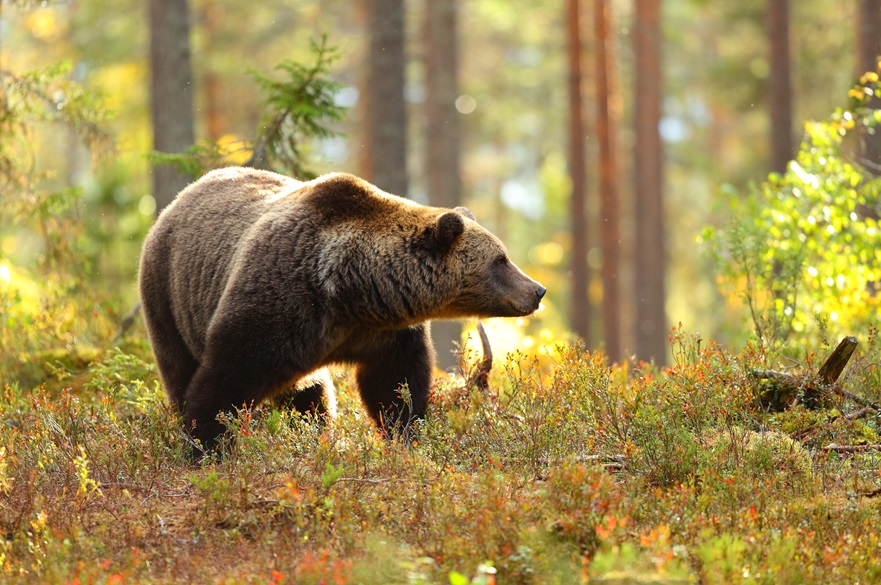Urgent need to better understand the impact of lead exposure in wild mammals, researchers warn
More needs to be done to understand the extent of harmful lead exposure in wild mammals, researchers have warned, after a study revealed how widespread it is among species across the globe.
By Dave Rogers | Published on 11 March 2024
Categories: Press office; Research; School of Animal, Rural and Environmental Sciences; School of Science and Technology;

Wildlife population health experts at Nottingham Trent University analysed almost 200 previous studies spanning more than 60 years and 35 countries to better understand the scale of the problem.
While more is known about the extent of lead exposure in bird species – where the first poisonings were recognised almost 150 years ago – this was the first review to focus on wild mammals.
There was lead in all 153 mammal species previously studied, the review found, with the most-researched species being red deer, European roe deer, wild boar, the wood mouse and brown bear.
Other species with lead poisoning included ringed seal, beluga whale, common wombat, European hare, Tasmanian devil, American manatee and stump-tailed macaque.
Despite all of the studies reporting lead concentrations in wild mammals, only a quarter investigated its health effects. These were always negative and ranged from subclinical to fatal and were found to have affected the nervous, circulatory and reproductive systems, the kidney, liver and teeth.
The researchers also say that a very small number of studies – just six percent – were carried out in developing countries where environmental pollution with lead is likely to be highest.
And while many mammal species were studied, the researchers argue, most focused on animals that were easy to access, such as hunted species and small mammals which can be trapped.
This meant that carnivores and scavenger species were less frequently studied than herbivores and omnivores.
Lead is a toxic, non-essential metal that occurs naturally in the Earth’s crust, and has historically been used in many products, including water pipes, paints, gasoline, ammunition, aviation fuel, motor vehicle batteries, glassware and cosmetics.
It is believed these human activities have increased the amount of environmental lead to around a thousand times the natural levels, thereby increasing the exposure and risk to wildlife.
Despite legislation banning or reducing the use of lead, it is still present in many products, including ammunition used to hunt game species.
The researchers hope further study of this area will create stronger evidence to influence policymakers involved in the regulation of products which contain lead.
“Lead exposure in wild mammals is an extremely serious issue,” said lead researcher Dr Helle Hydeskov, a scientist in Nottingham Trent University’s School of Animal, Rural and Environmental Sciences.
“It is clear that this is occurring in many species, across many countries and over many years. Little is known about lead exposure and its health effects on mammals, so more research is urgently needed.
“We need to better understand the impact on carnivores and scavengers. These animals are important for monitoring ecosystem health as lead accumulates in the body, and so it makes sense to study animals that eat other animals and that live for a longer period of time.
“More focus also needs to be put on countries expected to have the highest lead pollution, as well as developing countries with no or few regulations on lead.
“Helping to determine the impacts of lead on different species will add to our knowledge of this toxic metal and provide us with the necessary evidence to help with vital regulation.”
The study, which also involved NTU’s School of Science and Technology, the Inland Norway University of Applied Sciences and the Swedish University of Agricultural Sciences, is published in the Journal of Wildlife Diseases.
Notes for Editors
Press enquiries please contact Dave Rogers, Public Relations Manager, on telephone +44 (0)115 848 8782, or via email.
Nottingham Trent University (NTU) received the Queen’s Anniversary Prize for Higher and Further Education in 2021 for cultural heritage science research. It is the second time that NTU has been bestowed the honour of receiving a Queen’s Anniversary Prize for its research, the first being in 2015 for leading-edge research on the safety and security of global citizens.
The Research Excellence Framework (2021) classed 83% of NTU’s research activity as either world-leading or internationally excellent. 86% of NTU’s research impact was assessed to be either world-leading or internationally excellent.
NTU was awarded The Times and The Sunday Times Modern University of the Year 2023 and ranked University of the Year in the Whatuni Student Choice Awards 2023. It was awarded Outstanding Support for Students 2020 (Times Higher Education Awards), University of the Year 2019 (Guardian University Awards, UK Social Mobility Awards), Modern University of the Year 2018 (Times and Sunday Times Good University Guide) and University of the Year 2017 (Times Higher Education Awards).
NTU is the 5th largest UK institution by student numbers, with approximately 40,000 students and more than 4,400 staff located across five campuses. It has an international student population of 7,000 and an NTU community representing over 160 countries.
Since 2000, NTU has invested £570 million in tools, technology, buildings and facilities.
NTU is in the UK’s top 10 for number of applications and ranked first for accepted offers (2021 UCAS UG acceptance data). It is also among the UK’s top five recruiters of students from disadvantaged backgrounds and was the first UK university to sign the Social Mobility Pledge.
NTU is ranked the second most sustainable university in the world in the 2022 UI Green Metric University World Rankings (out of more than 900 participating universities).